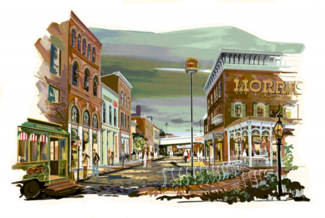Design for Progress
The Design for Progress was a master plan for downtown revitalization created in the early 1960s.
In 1962 the Downtown Improvement Association created Operation New Birmingham as a subsidiary committee charged with preparing and implementing a master plan for structural and economic redevelopment of downtown, dubbed the "Design for Progress".
The plan was created by Harland Bartholemew & Associates of Atlanta, Georgia with assistance from the Birmingham League of Architects. That plan, which debuted in 1965, envisioned major changes to the city center, with plazas and bridges creating a continuous raised pedestrian level, segregated from street traffic below. The plan also called for a historically-themed entertainment district on Morris Avenue and for a major new multi-venue performing arts and convention center, which was eventually developed as the Birmingham-Jefferson Civic Center.
Real estate developer William Engel put together a proposal for a $10 million federal office plaza project in the spirit of the Design for Progress. It would be located near the new Birmingham Post Office on the eastern end of downtown, and necessitated the demolition of the unused Birmingham Terminal Station. Though preservationists rallied to prevent the destruction of the landmark Beaux-Arts style station, the spirit of modernism prevailed. The office plaza project, however, was never realized.
Preservationists had more luck with the development of Old Town Uptown, a realization of architect Bob Moody's vision for an entertainment district modeled on Gaslight Square in St Louis, Missouri and Underground Atlanta in Atlanta, Georgia which filled a number of vacant warehouses on Morris Avenue with nightclubs and restaurants like Diamond Jim's, Oaks Street and Victoria Station. Though successful, the district's attractiveness proved vulnerable to fear after a visiting businessman was kidnapped, robbed and murdered in 1977.
While many elements of the Design for Progress never materialized, the plan was credited with triggering the development of several of Birmingham's tallest skyscrapers which were constructed in the downtown financial district in the 1970s and 1980s. Development of the AmSouth-Harbert Plaza in 1989 brought the first upscale indoor shopping mall and food court to downtown. It also housed Parisian, the last of the city's once plentiful major department stores to operate in the city center.
